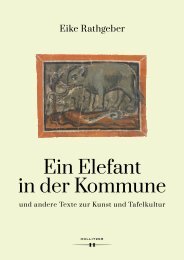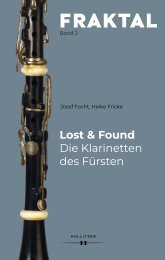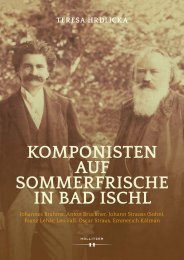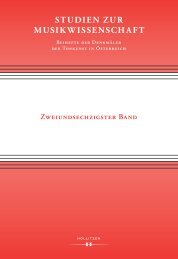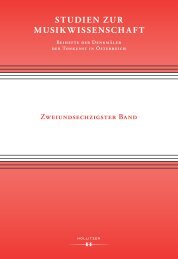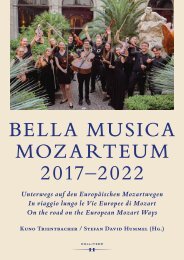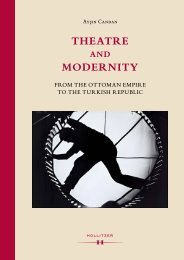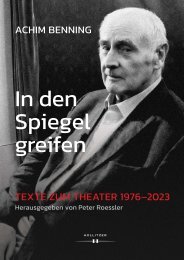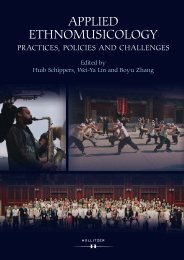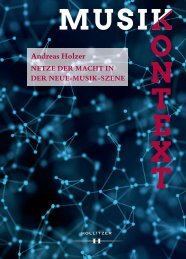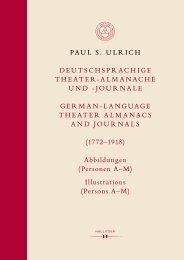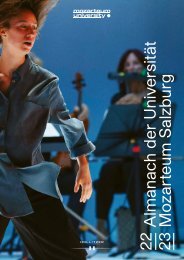You also want an ePaper? Increase the reach of your titles
YUMPU automatically turns print PDFs into web optimized ePapers that Google loves.
Andrea Lanzola<br />
1720: on August 28 <strong>Metastasio</strong> arranged for a performance of his work Angelica<br />
to celebrate the birthday of the Empress Elizabeth Christine of Brunswick-Wolfenbüttel,<br />
the wife of Charles VI, thus initiating a dense program<br />
of pro-Hapsburg propaganda that would carry over into the following<br />
year. The two protagonists, Medorus and Angelica, were interpreted<br />
by Carlo Broschi, also known as Farinello – <strong>Metastasio</strong>’s most<br />
intimate friend, referred to in correspondence as his “twin” – and by<br />
Marianna Bulgarelli Benti, known as la Romanina, the first of the “three<br />
Mariannas” who would feature in the poet’s life.<br />
1721: on May 30 the serenade Endimione was performed for the wedding of<br />
Antonio Pignatelli with Anna Francesca Pinelli di Belmonte; the composition<br />
was dedicated to Marianna, the groom’s sister, a lady-in-waiting at<br />
the Viennese court and the wife of Johann Michael von Althann. This<br />
work was followed on August 28 by Gli orti esperidi, again for the Empress’s<br />
birthday.<br />
1723: for his first dramatic endeavour, <strong>Metastasio</strong> revised an ancient libretto by<br />
Domenico David, La forza della virtù, staging it as Siface in honour of the<br />
viceroy Michael Friedrich von Althann, Johann Michael’s brother, with<br />
la Romanina as prima donna.<br />
1724–28: again in Naples, the opera Didone abbandonata was staged and set to music<br />
by Sarro (1724), followed two years later in Venice with Siroe re di Persia<br />
to the music of Leonardo Vinci, a young composer who, together with<br />
Jommelli and later Hasse, were favoured by <strong>Metastasio</strong> as advocates of a<br />
more natural melodic approach that distanced itself from the contrived<br />
contrapuntal baroque style still practiced in those years. Having returned<br />
to Rome towards the end of 1727, in the new year <strong>Metastasio</strong> staged his<br />
first oratorio Per la festività del SS. Natale, under the patronage of cardinal<br />
Ottoboni.<br />
1728–30: <strong>Metastasio</strong> moved between Rome and Venice, where his works were performed<br />
with increasing frequency, including the staging of Catone in<br />
Utica and Ezio (1728) and Semiramide riconosciuta (1729). On August 31,<br />
1729 he received an offer from Luigi Pio di Savoia, Superintendant of the<br />
Imperial theatres in Vienna, of the position of imperial laureate, his<br />
nomination having received the backing of his predecessor Apostolo<br />
Zeno. After completing his latest works – Alessandro nell’Indie and Artaserse<br />
– for the 1730 Roman and Venetian carnival, he accepted the appointment<br />
and reached Vienna on April 17, 1730, where he would remain<br />
for the next fifty-two years, except for brief spells in Czakathurn, Frain,<br />
and Joslowitz. Earlier that year he composed the Passione di Gesù Cristo.<br />
14



